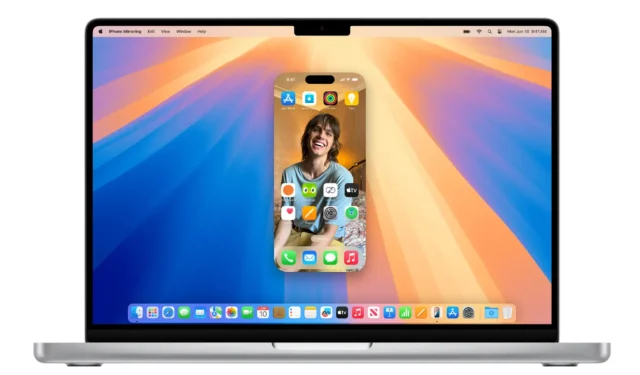
The recently launched iOS 18 and macOS Sequoia introduce a highly useful iPhone Mirroring feature that allows you to control your iPhone directly from your Mac’s display. This is undoubtedly one of my favorite features of macOS Sequoia, enhancing the interconnected experience across my devices. However, there may be times when iPhone Mirroring fails to work, leaving you uncertain about how to resolve the issue. This situation is quite common, as several prerequisites must be met for your iPhone screen to display on your Mac. Don’t worry! We’re here to guide you on how to enable and make use of iPhone Mirroring on your MacBook. Below, we’ve outlined 9 effective methods to help you troubleshoot and fix any iPhone Mirroring problems. Let’s get started!
Method 1: Check Device Compatibility
If you’re experiencing issues with iPhone Mirroring on your Mac, the first step is to confirm that your devices are compatible with this feature. iPhone Mirroring is an exclusive feature of macOS Sequoia, available only on devices that support iOS 18 and macOS Sequoia. This means you need a Mac equipped with either an Apple silicon chip or a T2 Security chip, along with a compatible iPhone model. If your devices aren’t compatible, iPhone Mirroring simply won’t work.
Method 2: Ensure You’ve Installed Both iOS 18 and macOS Sequoia
The iPhone Mirroring feature necessitates running iOS 18 on your iPhone and macOS Sequoia on your Mac. If your devices are still on iOS 17 or macOS 14 Sonoma, you’ll be unable to utilize iPhone Mirroring. Thus, it’s crucial to update your devices to access this exciting new feature.
After extensive beta testing, the stable versions of iOS 18 and macOS Sequoia are now widely available. To update your iPhone, navigate to Settings → General → Software Update and download iOS 18. For your Mac, go to System Settings → General → Software Update to download and install the latest macOS Sequoia.
After updating your devices, you should be able to use iPhone Mirroring wirelessly from your Mac without needing your iPhone to be physically nearby.
Method 3: Verify Your Apple ID
Once you’ve confirmed that both devices are up-to-date, the next step is to ensure that both your iPhone and Mac are signed in with the same Apple ID, with two-factor authentication enabled. This is essential for the functionality of iPhone Mirroring. If you are the primary user, you should have already signed in with the same Apple ID on both devices.
If you utilize multiple Apple IDs across different devices or are using a MacBook that belongs to someone else, you may need to switch your Apple ID. You can switch between different Apple IDs, but keep in mind that doing so will erase and replace all iCloud data, which might not be practical.
Here’s a simple way to check if you are using the same Apple ID on both your iPhone and Mac:
- On your iPhone, open the Settings app, tap on Your Name at the top, and check your Apple ID.
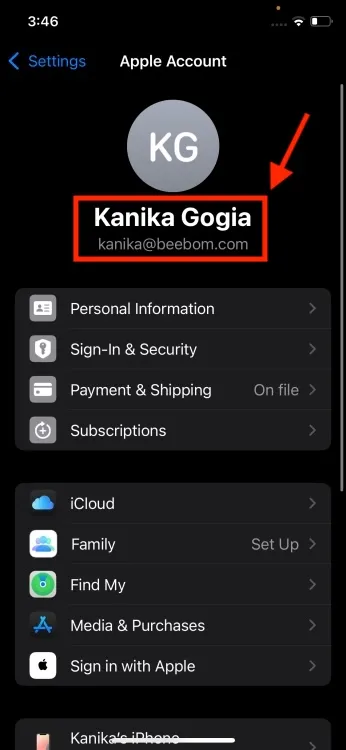
- On your Mac, navigate to System Settings, click on your name, and ensure that the Apple ID (email address) matches the one on your iPhone.

- If both devices display the same Apple ID, you’re all set!
- If the IDs differ, scroll down on the Apple Account screen and tap Sign Out on the device using the incorrect Apple ID.
- After signing out, sign in with the same Apple ID on both your iPhone and Mac.
Method 4: Enable Bluetooth and Wi-Fi on Both Devices
Another potential fix for iPhone Mirroring issues is to ensure that Bluetooth and Wi-Fi are enabled on both devices and that they are connected to the same Wi-Fi network. To facilitate iPhone Mirroring in macOS Sequoia, both Bluetooth and Wi-Fi need to be activated on your iPhone and Mac, and the two devices should remain close during the initial setup. Once you’ve set up iPhone Mirroring, you’ll have full access to your iPhone right on your Mac’s display, without needing your iPhone present.
To be thorough, here’s what you should check:
- On your iPhone, swipe down from the top-right corner to access the Control Center. Verify that Bluetooth is enabled and that you are connected to a Wi-Fi network.
- On your Mac, click the Control Center icon in the Menu Bar. Again, make sure Bluetooth is turned ON and that your Mac is connected to the same Wi-Fi network as your iPhone.
Method 5: Check If Your iPhone Is Locked
It’s crucial to note that iPhone Mirroring only functions when your iPhone is locked and not actively in use. If you unlock your iPhone, iPhone Mirroring will automatically cease until you lock the device again.
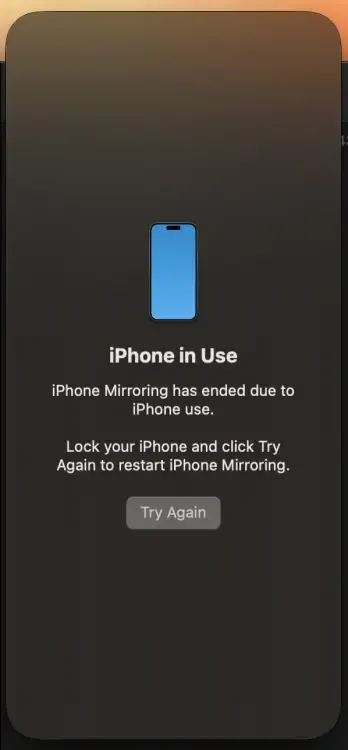
In fact, you’ll receive a notification on your Mac indicating that the iPhone is in use, prompting you to lock your iPhone and click on Try Again to continue mirroring. When iPhone Mirroring is active, your iPhone will display a message stating “iPhone in Use.”
Method 6: Ensure You Aren’t Using AirPlay or Sidecar
The iPhone Mirroring feature on macOS Sequoia cannot operate concurrently with AirPlay or Sidecar. Therefore, if you’re using AirPlay to stream content or mirror your iPhone screen to an Apple TV or another Mac, you need to disable AirPlay before trying again. Similarly, if you are utilizing the Sidecar feature to extend your Mac’s display with your iPad, iPhone Mirroring will not activate. To prevent conflicts, ensure that neither AirPlay nor Sidecar is active on your MacBook.
Method 7: Select the Right Devices
There may be situations where you have multiple iPhones signed in with a single Apple ID and wish to select a specific iPhone for use with iPhone Mirroring. In this circumstance, you will need to configure the iPhone you intend to utilize. If you’ve inadvertently chosen a different iPhone, you might think that iPhone Mirroring isn’t functional for you. To check, go to System Settings → Desktop & Dock on your Mac and scroll down to the Widgets section. Here, you will find a drop-down menu for selecting your iPhone for mirroring.
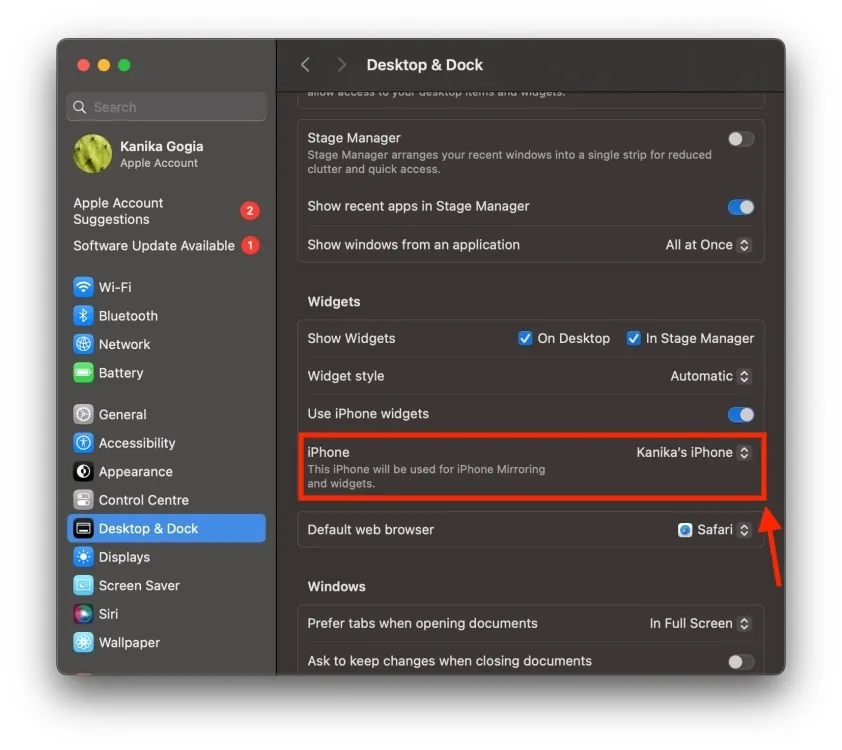
If you wish to use iPhone Mirroring on a different Mac, simply navigate to Settings → General → AirPlay & Continuity → iPhone Mirroring and select the desired Mac running macOS Sequoia.
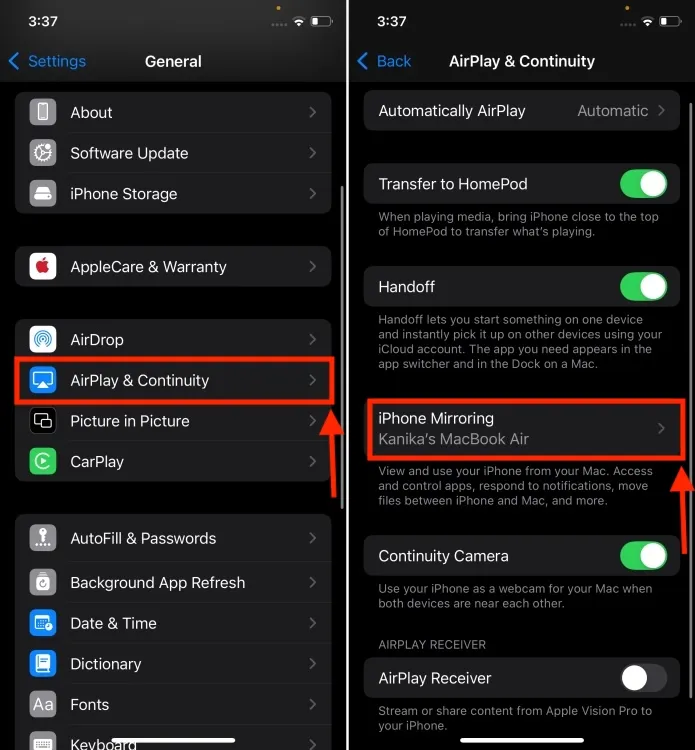
Method 8: Check iPhone’s Mirroring List
You might have inadvertently removed your Mac from the list of devices permitted to mirror your iPhone, which could explain why iPhone Mirroring is unavailable. This could happen by accident, possibly while lending your Mac to someone else. To check, go to Settings → General → AirPlay & Continuity → iPhone Mirroring and see if your Mac’s name appears on the list. If it’s missing, your Mac isn’t authorized to mirror your iPhone. In this case, re-enable iPhone Mirroring for your Mac.
Method 9: Restart Your Devices
If you have gone through all the troubleshooting steps and are still facing issues with iPhone Mirroring, try restarting both devices. Sometimes, minor software bugs and glitches can hinder the wireless connection between your iPhone and Mac. Thankfully, a simple reboot can often resolve these issues. So, make sure to restart both your iPhone and your Mac before attempting to use iPhone Mirroring again. In most cases, this should rectify the problem.
It’s important to mention that Apple has yet to introduce drag-and-drop capabilities to the iPhone Mirroring feature. Consequently, if you’re unable to transfer photos, videos, and files between your iPhone and Mac, don’t be alarmed. Apple plans to implement this functionality later this year.
We hope this article has assisted you in resolving any iPhone Mirroring issues and that you can now successfully mirror your iPhone to your Mac. Which method worked for you? We’d love to hear about your experiences in the comments below!




Leave a Reply